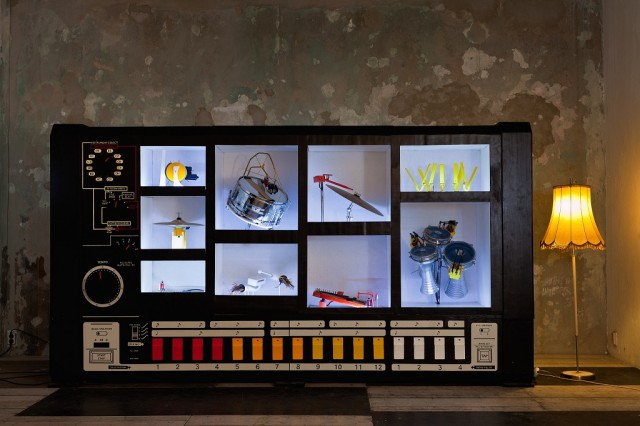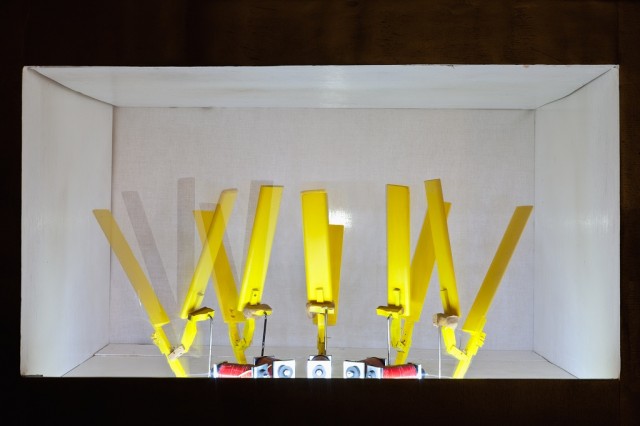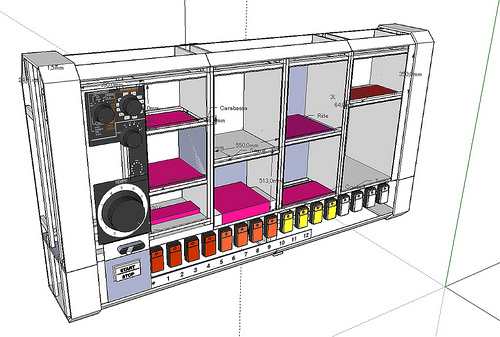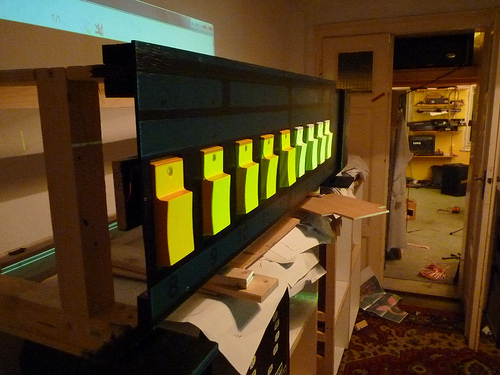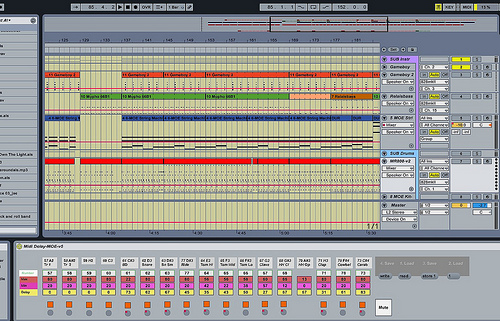So, you’re really hot stuff now that you’ve got a vintage Roland TR-808, huh? Ready to have your pride taken down a few notches? If you haven’t seen it, have a look at this.
The MR-808 is a “real-world” replica of the Roland sounds. And when people throw around buzzwords like “post-digital” to try to describe the spirit of the age in which we live, this is what they’re trying to get at. In some sense, this creation is a tribute to the 808’s minimalism and essential design. And this is still a creation of the digital realm. The robots are controlled by Arduino, a small embodiment of our computer world. There’s a Game Boy making drums. Sequences live in Ableton Live.
What the Sonic Robots project does is add another layer. The design brainchild of Dresden-based artist Moritz Simon Geist, the project makes the sounds itself escape code and circuits, and come back into physical, acoustic space.
That’s a fine gimmick, but there’s a lot of craft here. First off, the band itself is making some great music. They really are a band, and the project’s flash still passes the “close your eyes and you’ll still like it” test. They do some serious engineering – like accounting for latency. And by entering this physical domain, they reclaim the basics of sound design. Of all the insightful documentation, it’s great to read Simon talking about finding a perfect clap.
For music to be personally expressive, though, it doesn’t have to impress anyone but yourself. And that seems to be what motivated Simon to make this happen. (Hint: it tends to be behind any truly hard-working musician.) Boredom, here, was the mother of invention:
The robot installation MR-808 is a replica of the famous 1980s electronic drum machine TR-808 – with robots playing the drum sounds! I (Moritz Simon Geist) have been playing electronic music for several years now, and at some place I was bored of the electronic music production process. With binary logic, everything is possible.
So I decided to go back to the roots of sound generation – the physical sound generation – but combine it with the electronic music structure we like so much.
I liked the idea so much, that I couldn’t stop building my own drum robots, and ended up replacing all the electronic sounds of a whole drum computer, placed in a 3,3 x 1,7m² case. I am very proud to present the “MR-808” – a mechanic replica of the famous 1980s electronic drum machine TR-808!
First, one terrific video expresses the drama of this coming to life. It really is a kind of toy theater, the 808 made enormous, hollowed out, and filled with dancing physical objects:
MR-808 – mechanic drum robot from Sonic Robots on Vimeo.
What you’re actually hearing:
MR-808 – mechanic sound robot (all drums, miced)
A mechanic relay controlled via arduino (bass sound)
Gameboy – Arduinoboy hardware (8 bit chiptune sound)
Everything was programmed in Ableton, only equing and compression has been applied.
The band, the music video, the live act. Proving that they really are a band, Sonic Robots also have a lovely music video out. What’s great about it is that that theatrical backdrop makes the machines equal band members. Normally, tech – laptops or analog or otherwise – is mainly hidden, silent, flickering boxes that are effectively dead weight for an audience. Here, it’s as present as the humans.
Rise Of The Toys from Science Fiction Children on Vimeo.
Cinematography:
David Campesino
Philipp Baumgarten
Rise Of The Toys
Written by Science Fiction Children
Band:
Art Hustle
Moritz Simon Geist
Dr. Valentine
Katharina Hoffmann
Performed at Sputnik 2.0,
Dresden 2012
Only reverb, equing and compression has been applied to the tracks.
Solving latency. There’s an extensive article that deals just with how to keep all of this physical business operating in sync. One advantage of machine-sequenced music is that you don’t have to get so close to zero-latency. But that does mean engineering things to stay in time. Copiously documented:
A latency control concept for midi driven mechanic robotic instruments
Max/MSP does the heavy lifting here. The solution is simple, though – there’s just some use of the pipe object from Max/Pd. It’s more about trial and error, back in the physical world.
The machines. You’ll find extensive documentation of each detail of this rig:
http://sonicrobots.com/category/robot-technique/
There’s a run-down of the full setup, plus details of how the robotics work (ideal if you’re experimenting with Arduino and solenoids, even in more modest ways).
Every time I post something, I find someone in comments says “but you didn’t mention — [xxx]” – there’s even a quite-decent summary of robotic projects past.
The music. I’ll close with this. Perhaps you don’t need to build your own robotic physical 808. Maybe you just need a Game Boy and a tape machine. But whatever it is that makes you happy in making music, it’s worth following. And so I do enjoy the music Simon has produced:
And great work on the part of the whole band – hope to get to see y’all soon in person.
